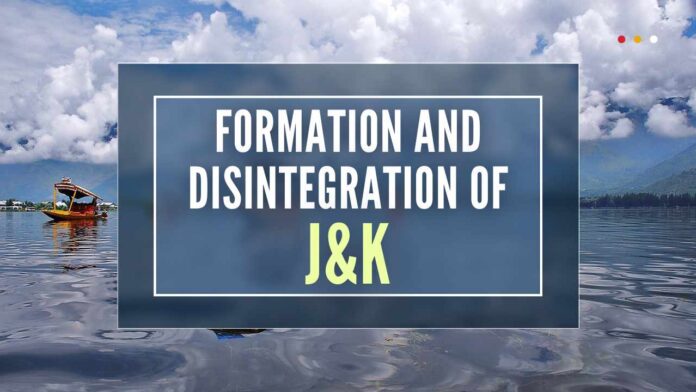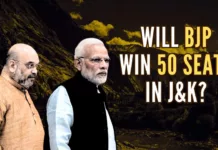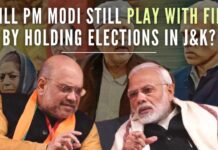
Kashmir became part of Dogra Kingdom, and not vice-versa
J&K State came into being at a time when other princely states were crumbling one after another under the pressure from the imperialist UK. It came into being in March 1846 under the Treaty of Amritsar, signed between Dogra Raja of Jammu, Gulab Singh, and the British. It was Kashmir that became part of Dogra Kingdom, and not vice-versa. Ladakh had become part of the Dogra Kingdom in 1834. The whole credit for this successful military expedition goes to Raja Gulab Singh’s General, Zorawar Singh, also called “Napoleon of the East”. Tibet, too, would have become part of the Jammu Kingdom, had bad weather not hampered General Zorawar Singh’s expedition and not died at the Battle of To-Yo on December 12, 1841.
It needs to be noted that the UK would not have signed the Treaty of Amritsar with the Dogra Raja, had the Lahore Darbar collapsed before 1846; it fell in 1849. The British knew the “unique importance of the Northern Frontier” which lay between Russia and Afghanistan.
That London had signed the Treaty under compulsion became clear in 1846 itself or that the seeds of disintegration of J&K were sown immediately after signing the Treaty could be seen from the letter of Lord Harding, Governor General of India (1844-48), to Gulab Singh. That year (1846), it started interfering in the internal affairs of J&K “ostensibly on behalf of the subjects of the state”, especially Kashmiri Muslims. So much so, the UK appointed an Officer-on-Special Duty in J&K in 1852, Commercial Agent at Leh in 1857, and British Joint Commissioner at the same place in 1870, established Gilgit Agency in 1875 to “obtain trustworthy information regarding military activities beyond the border” and “gain influence among the neighbouring tribes”, and appointed British Resident in J&K in 1889 after deposing Maharaja Pratap Singh on fictitious charges, including the charge that he had written “23 anti-British letters” to the Maharaja of Patiala. Pratap Singh was condemned unheard.
All these were gross violations of the Treaty of Amritsar, which didn’t provide for British interference in the state’s internal affairs. The four basic objectives of the UK behind these violations were to promote her geo-political interests in the region, control the state’s armed forces and finances, construct military roads leading to the strategic Ladakh and Ladakh’s Chitral, Gilgit, Baltistan, Hunza, etc, and check the Russian activities in the region so that Moscow failed to jeopardize its imperial interests in Afghanistan. And to achieve their objectives, the British officials, on the one hand, left no stone unturned to undermine the position of the otherwise unyielding Dogra Maharajas and, on the other, exploited to the hilt the Kashmiri Muslim clergy and other vested interests, who had been denouncing the Treaty of Amritsar as a “sale deed” and accusing the British of “bartering the life, honour, and dignity of Kashmiris” for Rs.75 lakh by “imposing the Dogra rule” in Kashmir. In short, both hatched conspiracies to destabilize the Dogra rule.
The history of relations between J&K and the UK and between the Dogra rule and Kashmiri Muslim leadership between 1846 and 1947, in short, was one of the intrigues against the Dogra rule: the UK conspired to promote its geo-political interests and the Kashmiri Muslim leadership launched one movement after another to ensure separation of Kashmir from Jammu. Of all the movements which the Kashmiri Muslim leadership launched to disintegrate J&K or ensure separation of Kashmir from Jammu, the ones which took place in 1913, 1924, 1931, and 1946 (Quit Kashmir Movement) were highly disturbing — disturbing in the sense that this movement, instead of bridging the gulf between Kashmir and Jammu, further widened it leading to an extreme form of bitterness and animosities between the regions and the communities.
The whole point is that the British officials and Kashmiri leadership worked in tandem to weaken the Dogra Kingdom and consistently denounced the Dogra rulers as intolerant, aliens, oppressors, and anti-Kashmiri Muslims to establish that they considered “Kashmiri Muslims worse than the brutes”. Sadly, however, the Congress and its leader JL Nehru gave their unstinted support to Sheikh Abdullah and his Quit Kashmir Movement and hailed it as a “freedom moment”. Nehru disliked Maharaja Hari Singh and stood solidly behind the Kashmir-based National Conference and its chief Sheikh Abdullah.
On October 26, 1947, Indian PM Nehru finally accepted Maharaja Hari Singh’s offer of accession but only after making Sheikh Abdullah a party to it, despite the fact that the Maharaja alone had the authority to decide the fate of his state. The offer was unconditional and the Instrument of Accession signed by Maharaja Hari Singh was similar to the one signed by other 560-odd princely states. Sadly, it was Nehru and Indian Governor General Mountbatten, who imposed conditions: Nehru made it clear that he would accept the accession offer on the condition that Sheikh Abdullah would handle J&K affairs and lead the state and Mountbatten in his letter/ note that accompanied the Instrument of Accession on October 27 suggested that people of J&K, and not the Maharaja, were the chief determinants – a clear violation of the Indian Independence Act.
It was hoped that the transfer of state power from Jammu to Srinagar with Sheikh Abdullah in the driving seat would, on the one hand, mollify the Kashmiri leadership and harmonize inter-regional relations and, on the other, hasten the process of integration of J&K into India. Unfortunately, it didn’t happen. What happened was to the contrary. Emboldened as he was, Sheikh Abdullah and members of his coterie – apart from converting Jammu and Ladakh into Kashmir’s two colonies and the citizens of these two regions as their subjects – started questioning the accession of J&K and demanding a dispensation virtually outside the political and constitutional organization of India. They started vouching for greater autonomy, bordering on virtual sovereignty. The Government of India, instead of checking the fissiparous tendencies in Kashmir – sided with them.
The results of the hobnobbing between the successive governments at the Centre, including those headed by the Congress and the BJP, and Kashmiri leaders were:
- Grant of separate status to J&K on the score of religion on October 17, 1949, through Article 370.
- Talks between Nehru and Sheikh in 1952 on the state’s political future.
- Application of Article 35A to J&K bypassing the Parliament on May 14, 1954, w.e.f. May 14, 1944 (when India was still under UK and J&K still a princely state) to declare all non-J&K residents persona-non-grata in J&K.
- The 1974 Indira Gandhi-Sheikh Abdullah Accord under which the deflated Sheikh was brought back to power in February 1975 armed with the power to review all the Central Laws introduced in J&K after August 9, 1953.
- The 1987 Rajiv Gandhi-Farooq Abdullah’s power-sharing accord.
- The 2002 written agreement between the Sonia Gandhi-led Congress and the PDP chief and an ardent believer in the concept of self-rule and Indo-Pak joint control over J&K, Mufti Mohammad Sayeed, under which the state power was handed over to him in what AICC chief Sonia Gandhi called “national interest.
- The 2006-07 Round Table Conferences at the official residence of PM Manmohan Singh with Manmohan Singh himself saying “there is the need for a consensus over the twin issues of autonomy and self-rules within the vast flexibilities provided by the Indian Constitution”.
- The 2008-2009 power-sharing agreement between the Congress and the protagonist of greater autonomy National Conference under which the state power was handed over to Omar Abdullah for a full six-year term.
- The March 1, 2015, written agreement (highly divisive Agenda of Alliance) between the BJP and Mufti Sayeed led to the transfer of the state power to the PDP for the full term.
- The January-April 2016 parleys between the BJP top leadership and Mehbooba Mufti on the nature of authority she would exercise as J&K CM.
All these accords, agreements, and negotiations were over the heads of the people of Jammu and Ladakh whom New Delhi and Kashmiri Muslim elite considered no factor in the state’s political situation.
To say all this is not to suggest that New Delhi didn’t act in between. It did. Nehru himself had Sheikh Abdullah dethroned and arrested on August 9, 1953, under the charge of sedition. J&K was brought under Governor’s Rule/ President’s Rule seven times. Even today, it is under the President’s Rule since June 19, 2018. Mehbooba Mufti-led PDP-BJP coalition government was brought down on June 18, 2018, on the ground that it had become a threat to national security and Mehbooba Mufti had ill-treated Jammu and Ladakh. Jamaat-e-Islami was banned. Hurriyat Conference was reined in. Many top separatists were either put under house arrest or sent to Tihar. Articles 35A and 370 were abrogated on August 5-6, 2019. J&K state itself was divided into two Union Territories – UT of J&K and UT of Ladakh – on the same day. Almost all the so-called mainstream Kashmiri leaders were kept under house detention or in make-shift jails between August 4, 2019, and August 2020. The age-old practice of Darbar moves scrapped. All the Central Laws were introduced in J&K UT between August 2019 and August 2022. The state holiday on the birthday of Sheikh Abdullah cancelled and the holiday on the birthday of Maharaja Hari Singh and the holiday on October 26 (accession day) was declared as state holidays.
Did these reforms and actions produce the desired results? The answer is not in the affirmative. The attitude of the Kashmiri leaders of all hues towards India and Indians and the people of Jammu and Ladakh remains the same. The statements emanating from Gupkar and other places in Kashmir from time to time establish that they continue to feel “alienated” from the Indian State and continue to vouch for what they started vouching for in 1947. The situation has now climaxed to the point that former CM Mehbooba Mufti has openly incited the people of J&K (in this case Muslims) against the Indian State. Only on November 14, she said: “If people of J&K unite as India did against the British, we can achieve more than special status”. And remember, she is vice-chairperson of the Gupkar Alliance, which stands for what I have explained. Neither its chairperson Farooq Abdullah nor any other member of the Gupkar Alliance has distanced himself/ herself from the seditious statement that she made.
The ongoing process of disintegration of J&K — its division into two UTs and creation of Ladakh as a UT out of the erstwhile J&K State — has to be viewed in this context. And, there are potent reasons to believe that Jammu, which created such a vast state in 1846, will, too, come out of the existing J&K UT sooner than later and the responsibility for the further disintegration will be squarely on the shoulders of the Kashmir-based sympathizers of Pakistan and China and votaries of autonomy, self-rule, porous borders, demilitarization, dual currency, and achievable nationhood.
Note:
1. Text in Blue points to additional data on the topic.
2. The views expressed here are those of the author and do not necessarily represent or reflect the views of PGurus.
PGurus is now on Telegram. Click here to join our channel and stay updated with all the latest news and views
For all the latest updates, download PGurus App.
- ‘Kashmir My core constituency’: Revisiting July 12, 2003 to understand politics, Omar Abdullah-style - March 15, 2024
- Total deviation from traditional approach: Seven takeaways from PM Modi’s March 7 Srinagar visit - March 9, 2024
- Status of political parties: Why is further J&K reorganization imperative? - March 1, 2024










